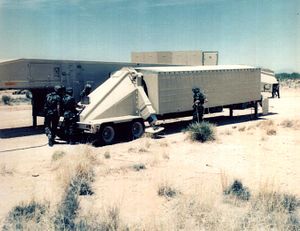A few curated defense and security links to start off the week:
The United States’ decision to recently deploy an anti-missile X-band army navy/transportable radar surveillance (AN/TPY-2) radar system at a base in Japan’s Kyoto prefecture has irked China. Answering a question about this recent U.S. radar deployment, Chinese foreign ministry spokesperson Hua Chunying remarked, “The anti-missile deployment in the Asia-Pacific by a certain country in the pursuit of unilateral security goes against regional strategic stability and mutual trust, as well as peace and stability in Northeast Asia.” The spokesperson was careful not to name the United States specifically. According to a U.S. Missile Defense Agency fact sheet, the AN/TPY-2 is a “transportable X-band, high-resolution, phased-array radar designed specifically for ballistic missile defense.”
The Wall Street Journal ran a lengthy feature this weekend looking at the growing role of China’s submarines. The piece makes the case that Beijing’s evolution from a coast-bound naval power to a global naval power will be led by its submarine force. Additionally, with the impending launch of nuclear-strike capable “boomer” submarines, Beijing will have the capability to project power across the Pacific and Indian Oceans. The WSJ cites an article by Chinese navy chief Adm. Wu Shengli where these “boomers” are described as “a trump card that makes our motherland proud and our adversaries terrified.” A companion piece by the same author takes a look at what the United States is doing to keep track of China’s submarines. A major asymmetry in the relationship today is seen in the vast rift between the United States’ and China’s anti-submarine warfare (ASW) capabilities.
An internal report by the Indian Air Force criticizes the serviceability rate for India’s fighter fleet. According to IHS Jane’s 360, “operational availability of the Indian Air Force’s (IAF’s) combat, transport, and helicopter fleets has averaged about 60 percent over the past three years.” The availability rates for Indian military transport aircraft and the helicopter fleet were hardly higher at 65 and 62 percent respectively.
Gen. Curtis Scaparrotti, the commander of U.S. Forces Korea, remarked that he did not believe that Kim Jong-un was ever out of power during his recent 40 day absence from the public eye. “We didn’t see any discernible change that led us to believe there was an instability while he was gone,” he said. Gen. Scaparrotti’s remarks highlight the Pentagon’s assumptions about North Korean behavior remaining constant despite Kim’s recent disappearance. Despite widespread speculation, largely from the mainstream media, that Kim Jong-un had been deposed or overthrown, his recent appearance confirmed that he remained in charge. In the same Pentagon press conference, Gen. Scaparrotti drew attention when he suggested that North Korea has the technology to miniaturize a nuclear device. “I think they certainly have had the right expertise in the past, they have the right connections, so I believe they have the capability to have miniaturized a device at this point, and they have the capability to deliver what they say they have,” he said. “I have not seen it tested, and I don’t think as a commander, I can afford the luxury of believing they haven’t gotten there.”
Pakistan’s Chief of Army Staff Raheel Sharif (no relation to Pakistan’s Prime Minister Nawaz Sharif), the country’s senior-most military leader, will visit the United States for the first time since assuming the position last November next month. According to Pakistan’s DAWN, Sharif will discuss strategic issues with U.S. military commanders and defense officials. Sharif will visit the U.S. on a personal invitation from the Chairman of the U.S. Joint Chiefs of Staff, Gen. Martin Dempsey. U.S. leaders will likely be keen to learn of Sharif’s plans for the Pakistani army’s ongoing campaign against the Tehreek-e-Taliban Pakistan (TTP) in the country’s tribal regions, and of the current political situation in Pakistan.

































